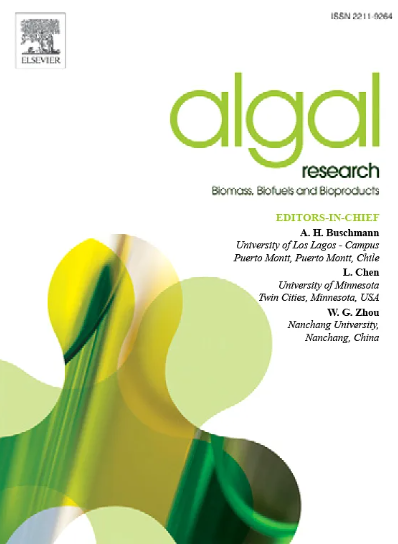Physiochemical insights into substrate-diatom adhesion: Influence of surface properties on biofilm dynamics and productivity
IF 4.6
2区 生物学
Q1 BIOTECHNOLOGY & APPLIED MICROBIOLOGY
Algal Research-Biomass Biofuels and Bioproducts
Pub Date : 2025-03-28
DOI:10.1016/j.algal.2025.104024
引用次数: 0
Abstract
Diatoms play a significant role in biofilm formation due to their unique surface properties and robust extracellular polymeric substance (EPS) production. This study investigates the influence of substrate and diatom surface physiochemical parameters on adhesion and biofilm productivity. Using Amphora coffeiformis COR_3 and Nitschzia microcephala COR_2 as a model organism, results highlighted that the adhesion density varied significantly with substratum type. The strongly polar N. microcephala COR_2 cells (γp = 32.5 ± 0.89 mJ/m2) favored increased adhesion towards glass with adhesion density of 3.017 × 105 cells/mm2. Conversely, A. coffeiformis COR_3 with its intense dispersive component (γLW = 24.1 ± 0.08 mJ/m2) promoted strong adhesion towards PE with adhesion density of 2.938 × 105 cells/mm2. A. coffeiformis favored adhesion with hydrophobic substrates via van der Waals interactions, facilitated by hydrophobic methylene groups on its surface. While, N. microcephala promoted adhesion with the hydrophilic substrates through acid-base interactions and hydrogen bonding. These findings are further complemented by the varying EPS composition with A. coffeiformis producing protein-rich EPS on hydrophobic substrates, while N. microcephala releasing carbohydrate-rich EPS on hydrophilic substrates. This surface chemistry driven biofilm formation provides a baseline for optimizing the diatom-substrate pairs to enhance biofilm performance in industrial applications.

基质-硅藻粘附的物理化学见解:表面特性对生物膜动力学和生产力的影响
硅藻由于其独特的表面特性和强大的胞外聚合物(EPS)生产,在生物膜的形成中起着重要的作用。本研究探讨了底物和硅藻表面理化参数对生物膜粘附和产率的影响。以咖啡双耳(Amphora coffeiformis) COR_3和小头尼氏(Nitschzia microcephala) COR_2为模型生物,黏附密度随基质类型的不同而有显著差异。强极性N. microcephala COR_2细胞(γp = 32.5±0.89 mJ/m2)对玻璃的粘附增强,其粘附密度为3.017 × 105 cells/mm2。相反,A. coffeiformis COR_3具有较强的分散成分(γLW = 24.1±0.08 mJ/m2),对PE具有较强的粘附性,其粘附密度为2.938 × 105个细胞/mm2。A. coffeiformis倾向于通过范德华相互作用与疏水底物粘附,这是由其表面的疏水亚甲基促进的。而小头藻则通过酸碱相互作用和氢键作用促进与亲水性底物的粘附。不同的EPS组成进一步补充了这些发现,咖啡拟虫在疏水底物上产生富含蛋白质的EPS,而小头棘虫在亲水底物上释放富含碳水化合物的EPS。这种表面化学驱动的生物膜形成为优化硅藻-底物对以提高工业应用中的生物膜性能提供了基线。
本文章由计算机程序翻译,如有差异,请以英文原文为准。
求助全文
约1分钟内获得全文
求助全文
来源期刊

Algal Research-Biomass Biofuels and Bioproducts
BIOTECHNOLOGY & APPLIED MICROBIOLOGY-
CiteScore
9.40
自引率
7.80%
发文量
332
期刊介绍:
Algal Research is an international phycology journal covering all areas of emerging technologies in algae biology, biomass production, cultivation, harvesting, extraction, bioproducts, biorefinery, engineering, and econometrics. Algae is defined to include cyanobacteria, microalgae, and protists and symbionts of interest in biotechnology. The journal publishes original research and reviews for the following scope: algal biology, including but not exclusive to: phylogeny, biodiversity, molecular traits, metabolic regulation, and genetic engineering, algal cultivation, e.g. phototrophic systems, heterotrophic systems, and mixotrophic systems, algal harvesting and extraction systems, biotechnology to convert algal biomass and components into biofuels and bioproducts, e.g., nutraceuticals, pharmaceuticals, animal feed, plastics, etc. algal products and their economic assessment
 求助内容:
求助内容: 应助结果提醒方式:
应助结果提醒方式:


